Summary:
- PepsiCo’s announced Q1-23 results that beat even my above-consensus expectations, reporting 10.2% revenue growth (14.3% organic) and $1.5 EPS, representing 3.3% and 8.0% beats compared to the consensus respectively.
- In another quarter of industry-leading growth, the staple giant continued to outperform its much-smaller peers, demonstrating unparalleled brand value and immense pricing power.
- PepsiCo is one of those companies that always seems overvalued on paper. Waiting for a bargain price with such high-quality companies can be a frustrating endeavor.
- As markets shift to a “risk-on” mode, PepsiCo’s stock experienced a minor sell-off, which I view as a great buying opportunity.
- I reiterate a Buy rating with a price target of $209.8 per share.
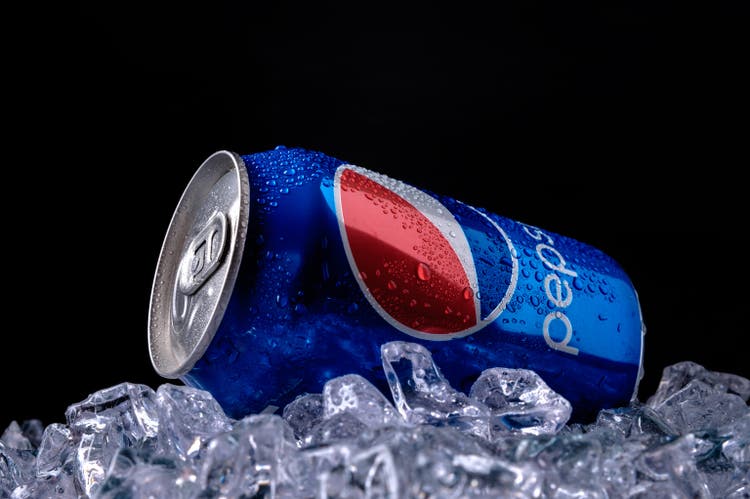
Fotoatelie
PepsiCo (NASDAQ:PEP) announced its Q1-23 results that beat expectations, reporting 10.2% revenue growth (14.3% organic) and $1.5 EPS, representing 3.3% and 8.0% beats, respectively. The company is showing signs of easing inflation and continues to demonstrate immense pricing power, as gross margins came in at 55.2%, near its all-time highs. Despite being the largest in most of its operating categories PepsiCo’s organic growth remains industry-leading, reflecting the strength of its brands and the quality of its management.
As markets shift to a “risk-on” mode, PepsiCo’s stock experienced a minor sell-off, which I view as a great buying opportunity. After another 10.0% dividend increase, I reiterate a Buy rating with a price target of $209.8 per share.
Background
Two months ago, I published an article about PepsiCo and rated the stock a Buy. I urge you to read that article, in which I explained my investment thesis in detail, and why I find PepsiCo one of the highest quality consumer staple companies, as well as described the company’s operating segments, and risks, and provided detailed comparisons to the company’s competitors.
In short, my investment thesis is based on PepsiCo’s brand value, pricing power, and ambitious management, which are demonstrated by the company’s constant market share gains and industry-leading growth despite it being the largest in size in most categories. In the March article, I showed that PepsiCo’s organic growth came in either first or second in each of its major segments.
Regarding valuation, I showed that PepsiCo trades around the peers’ average valuation, which I find to be unappreciative of the company’s leading position.
Now, let’s focus on the company’s results, see if it remained a leader in terms of organic growth, and look at how my projections fared compared to the consensus. Then, we’ll update our projections and financial model accordingly.
Q1-23 Highlights
PepsiCo reported consolidated revenues of $17.8B, a 10.2% increase from the prior year period. Based on its historical seasonality, the company is on pace to deliver 7.4% revenue growth for the entire year. I’m glad to see the company is on pace to beat my initial $91.0B estimate, which means it’s on pace to beat the initial consensus expectations as well, and by a wide margin.
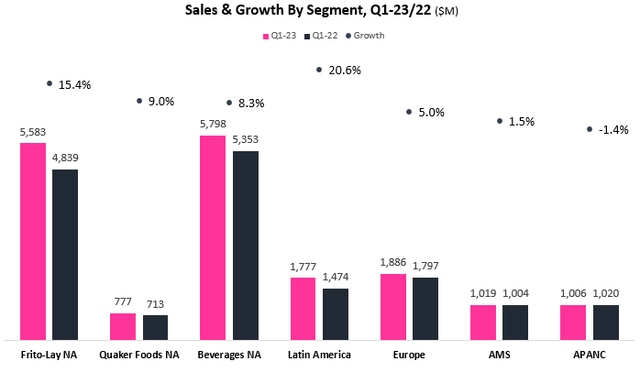
Created and calculated by the author using data from PepsiCo’s financial reports; AMS = Africa, Middle East, South Asia; APANC = Asia Pacific, Australia, New Zealand, China.
As we can see, besides APANC, every segment saw revenue growth compared to the prior year period. Frito-Lay North America increased by 15.4%, Quaker Foods North America increased by 9.0%, Beverages North America increased by 8.3%, Latin America increased by 20.6%, Europe increased by 5.0%, AMS increased by 1.5%, and APANC decreased by 1.4%.
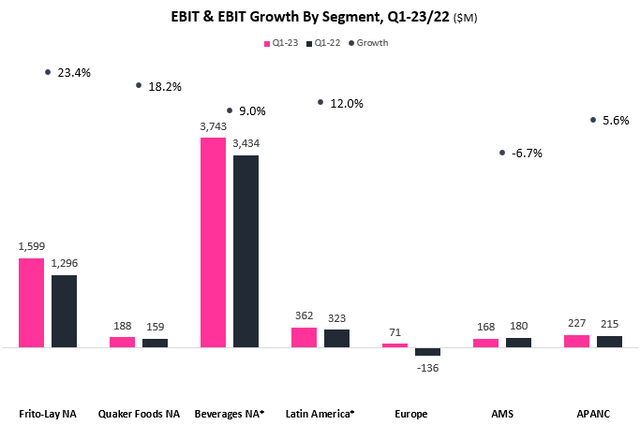
Created and calculated by the author using data from PepsiCo’s financial reports; Beverages NA and Latin America are adjusted for unusual items.
Looking at operating profit per segment, we see broad-based growth as well. Frito-Lay NA grew by 23.4%, as margins increased by 1.9 percentage points. Quaker Foods NA increased by 18.2%, with a similar margin expansion. Beverages NA grew by 9.0%, as margins expanded by 40 bps. Latin America grew by 12.0%, as revenue growth was offset by a margin contraction of 1.6 percentage points, primarily due to FX. Europe returned to profit, AMS decreased by 6.7%, and APANC grew by 1.5%, all due to a mix of revenue growth and FX impact.
Overall, PepsiCo’s results were very impressive, as the company continues to lean on its brand value to increase prices to offset inflation, while demand remains essentially unaffected and continues to grow despite higher prices.
Revisiting The Investment Thesis – Organic Growth Showdown
In my previous article, I summarized my investment thesis into two measurable aspects:
In an old-timer and a behemoth like PepsiCo, I look for two important attributes to assess whether it’s an attractive long-term investment which will provide compounding shareholder returns – ambition and relevancy.
First, I want to see that the company is still ambitious, meaning it’s still attempting to grow and increase efficiency, as opposed to squeezing what’s left from its old brands. This attribute is reflected in the company’s regular operating metrics.
Second, I want to make sure the company’s brands remain relevant, meaning the company is either keeping or gaining market share. This attribute is best reflected in the company’s organic growth, as it’s a combination of price, mix, and volume of existing brands.
We examined the first aspect in the previous section. Now, let’s turn to the second one.
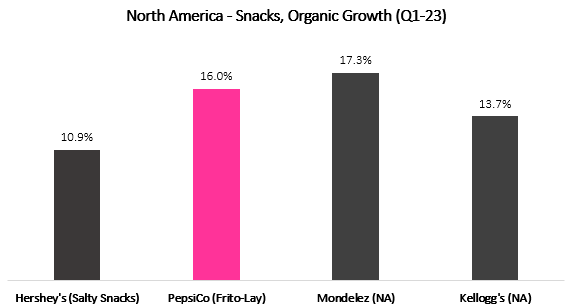
Created by the author using data from the companies’ financial reports.
In the Snacks category, PepsiCo grew organically by an impressive 16.0%. It outgrew Hershey (HSY) and Kellogg’s (K) but lagged Mondelez (MDLZ). This is all the while more impressive considering the fact that PepsiCo’s Frito-Lay segment generated revenues of $5.6B, compared to the much smaller Hershey’s $270M, Mondelez’s $2.7B, and Kellogg’s $2.4B. Looking at the Snacks category, PepsiCo checks all my boxes. Although it’s the largest by a wide margin, the company is outgrowing its smaller peers, reflecting pricing power, and relevancy.

Created by the author using data from the companies’ financial reports.
In the Other Foods category, which includes cereal, oats, pasta, and other dry foods, PepsiCo came behind General Mills (GIS) by a wide margin. It should be noted General Mills is also much larger, with revenues of $3.2B in the quarter, compared to PepsiCo’s $777M. However, in a vacuum, 10.0% organic growth is quite impressive, especially as the other foods category isn’t a core business for PepsiCo, unlike General Mill’s.
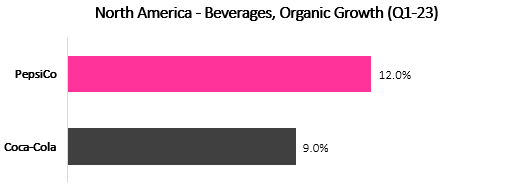
Created by the author using data from the companies’ financial reports.
This wouldn’t be a real analysis of PepsiCo without comparing it to Coca-Cola (KO) right? Well, PepsiCo outperformed Coca-Cola by 3 percentage points in the quarter. Moreover, PepsiCo has a much larger presence in the North American beverage market, with total sales of $5.8B compared to Coca-Cola’s $3.9B.
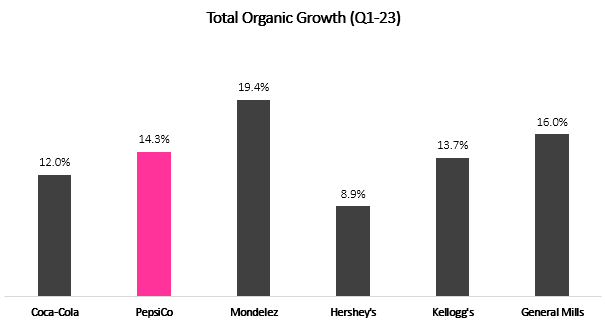
Created by the author using data from the companies’ financial reports.
On a consolidated basis, we find PepsiCo in third place behind Mondelez and General Mills. Not to sound too repetitive, but with $17.8B in sales in the quarter, PepsiCo generated more than three times the revenues of General Mills ($5.1B), and almost twice the revenues of Mondelez ($9.1B). Needless to say, PepsiCo is much larger than the rest of the companies on our list.
Overall, I find PepsiCo’s growth numbers to be extraordinary. The company is either first or second in every category, despite being the largest in terms of sales. To me, this is clear proof that PepsiCo’s brands are more relevant than ever. The company is able to pass most of its costs to its customers and possesses strong pricing power, which is what makes PepsiCo such a stable business.
Important Notes From The Call
Given the strength of our business performance, we now expect our full-year 2023 organic revenue to increase 8 percent (previously 6 percent) and our core constant currency earnings per share to increase 9 percent (previously 8 percent).
— Q1-23 Earnings Prepared Management Remarks 04/25/23
PepsiCo is now expecting a 2 percentage point higher organic growth, primarily due to better-than-expected resiliency in demand despite pricing actions.
When it comes to pricing, as we said earlier in February, we have mostly taken the pricing already this year that we needed to cover for our cost increases, and it’s where we stand at this point. We’re seeing a deceleration of inflation, not a reduction of cost but a deceleration of inflation, and we think that with the pricing that we’ve taken already, most of our business around the world that should be sufficient. Obviously, there are some markets, highly inflationary markets around the world, where we might have to take additional pricing. If you think about Argentina, Turkey, Egypt – those kinds of markets where the currencies are suffering – but majority of our pricing is already done.
We tend to buy commodities 9 to 12 months out. So to the degree that the rate of inflation decreases – and it will be a decrease in the rate of inflation, not deflation by any stretch of the imagination, that’s going to happen very slowly over the course of 2023. I think that’s more of a 2024 thing, to the degree it happens even then.
— Ramon Laguarta – Chairman & CEO, Q1-23 Earnings Call
According to the management, most of the pricing action is done. Price is still going to be a growth factor in the following quarters, as they overlap quarters of lower prices. After that, we should expect growth to be primarily driven by volume. Additionally, the company is seeing a deceleration in inflation, but it will take time until we see its effect in the results.
In general, the flow of materials, the availability of labor, transportation, all those elements [are…] getting better, which is giving us the opportunity to improve some of the metrics in our operations faster than what we thought. So it’s both an improvement in productivity on the cost side and better elasticity.
— Ramon Laguarta – Chairman & CEO, Q1-23 Earnings Call
After three years of supply chain issues being a major talking point, we’re finally seeing a recovery, and PepsiCo is clearly improving operational efficiency, as evidenced by the margin expansion.
Our categories are large and growing at a very fast pace, around 5% globally. Our main responsibility is to maintain innovation and make sure that the portfolio evolves with consumers, and that the brands continue to be super relevant. And that is where we want to focus our efforts. We’re making some small moves, for example, we’re going into low alcohol here in the US. We’re making small moves like Cheetos going into Mac ‘n Cheese. So we’re expanding some of our brands organically into some new spaces that make sense from the consumer point of view.
— Ramon Laguarta – Chairman & CEO, Q1-23 Earnings Call
Regarding the long-term strategy, we see PepsiCo’s management continues to believe its core operations will be the primary focus. However, there are some relevant categories management believes it can penetrate with existing brands. In my view, we can expect PepsiCo to continue to grow at around a 5.0% pace over the foreseeable future, as it will constantly beat the industry pace by a slight margin.
Valuation
In my previous article, I detailed my Q1-23 projections as follows:
For Q1-23, I expect revenues of $17.4B, EBITDA of $2.9B, and net income of $1.8B, whereas the consensus projects $17.2B in revenues and a similar net income.
As we can see, I was closer than the consensus, but still missed by a wide margin, as PepsiCo significantly outperformed expectations. Based on the Q1 results, I now expect Q2-23 revenues of $22.5B (consensus is $21.7B), Operating Profit of $3.5B, EBITDA of $4.2B, and Net Income of $2.6B (consensus is $2.7B).
For the year, I expect revenues of $92.8B (consensus is $91.0B), Operating Profit of $51.2B, EBITDA of $17.2B, and Net Income of $10.6B (consensus is $10.1B).
As a consequence of the quarterly adjustment, I need to update my long-term model as well. I continue to project PepsiCo will grow revenues at a CAGR of 4.9% between 2023-2028, which is according to the company’s long-term growth targets. I believe revenues will grow at that pace due to constant capacity enhancements, steady price increases, and the company’s ability to continue to bring in new products with a focus on new trends like healthier snacks or zero-sugar drinks. I find this growth rate to be conservative, as it assumes PepsiCo will grow at the pace of the convenient foods and beverage markets, although historically PepsiCo outperforms the market and its peers as it constantly gains more market share.
I project PepsiCo’s EBITDA margins to increase incrementally up to 20.1%, as inflation eases and the supply chain continues to recover, along with new manufacturing lines finishing their ramp-up stage and productive initiatives materialize.
Overall, my assumptions result in EBITDA growth higher than revenues, reflecting operational leverage and cost-efficiencies. This is according to the management’s guidance of sequential operating margin expansion at a rate of 20-30 bps per year.
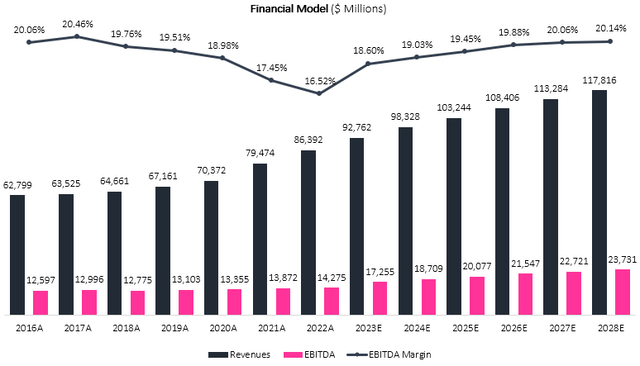
Created and calculated by the author based on PepsiCo’s financial reports and the author’s projections
Taking a WACC of 7.2%, I estimate PepsiCo’s fair value at $289.0B or $209.8 per share, which reflects a 14.3% upside compared to the market value at the time of writing. This represents a 25.0 P/E multiple on my 2024 EPS projection, which is in line with the company’s 5-year average.
Conclusion
Once again, PepsiCo demonstrated brand value, unparalleled pricing power, and significant market share gains in Q1-23. The company’s management remains impressively ambitious and isn’t resting on past success. Despite being the largest player in most of its categories, PepsiCo continues to grow at an industry-leading pace, coming first or second in terms of relative organic growth. As markets shift to a “risk-on” mode, PepsiCo’s stock experienced a minor sell-off, which I view as a great buying opportunity. Thus, I reiterate a Buy rating.
Analyst’s Disclosure: I/we have a beneficial long position in the shares of PEP either through stock ownership, options, or other derivatives. I wrote this article myself, and it expresses my own opinions. I am not receiving compensation for it (other than from Seeking Alpha). I have no business relationship with any company whose stock is mentioned in this article.
Seeking Alpha’s Disclosure: Past performance is no guarantee of future results. No recommendation or advice is being given as to whether any investment is suitable for a particular investor. Any views or opinions expressed above may not reflect those of Seeking Alpha as a whole. Seeking Alpha is not a licensed securities dealer, broker or US investment adviser or investment bank. Our analysts are third party authors that include both professional investors and individual investors who may not be licensed or certified by any institute or regulatory body.
